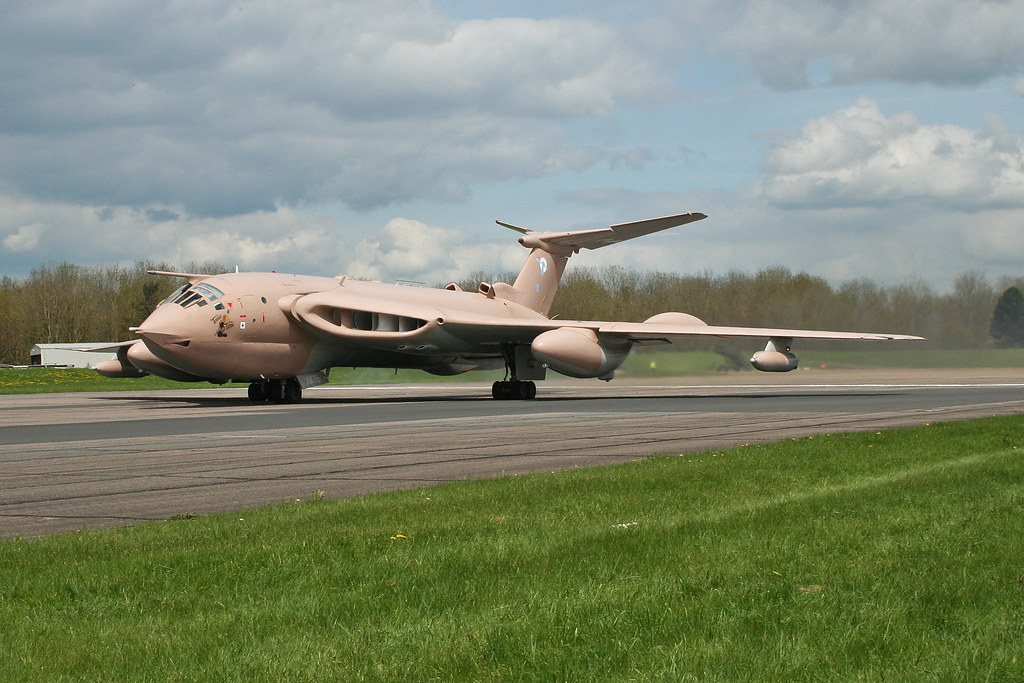Cleaning one of the two British Victor nuclear bombers still operational
The Royal Air Force (RAF) of the United Kingdom was one of the most powerful air forces of the Cold War, and one of the few with nuclear capabilities.
The RAF operated three famous types of nuclear-capable bombers, known as the V-bombers by their names: Valliant, Vulcan and Victor. The newest of the three was the Handley Page Victor. It made its first flight in 1952 and entered service with the RAF in 1958. A total of 86 Victor bombers were built, in three variants: HP.80 (2 prototypes), B.1 (50 units ) and B.2 (34 units).
Only 5 Victors survive today, of which 2 are in working condition: XH648, owned by the Imperial War Museum in Duxford, and XM715 Teasin' Tina/Meldrew, which is part of the collection of the Bruntingthorpe Cold War Jets Museum.

The XM715 was part of the fourth and final batch of the B.2 variant. It made its first flight on December 31, 1962 and was delivered to the RAF in March 1963, according to the official website of this plane. It was assigned to 100 Squadron in May 1963. In 1965 it was converted to a B.2 (SR), a strategic reconnaissance variant. It had a short operational life: XM715 was withdrawn from service in December 1967 after irreparable cracks were discovered in the root of its port wing.

On April 10, 1975, XM715 made its first flight as a Victor K.2, a mid-air refueling variant. He was assigned to 55 Squadron at RAF Marham. This aircraft participated in the Falklands War (1982) and the Gulf War (1990-1991). Its service in the RAF ended in 1993. After its withdrawal from service, it was purchased by the Walton family, who took it to Bruntingthorpe airfield, in Leicestershire (England), to add it to their collection of Cold War aircraft.

After a restoration process, the plane was put into operation and gave its pilots a scare on May 3, 2009, when during a high-speed run it took off from the ground, reaching 100 feet (30 meters) of altitude. It was the last flight of a Victor bomber. You can see the video of that last flight here, published by Airshow World:
On January 1, Partridge Exterior Cleaning posted a video showing the cleaning of the XM715 fuselage with pressurized water:
You can see some screenshots from the video here. Here we can see the state the plane was in before cleaning.

An image that shows us the tail of the XM715.

The starboard wing refueling nacelle. The Victor K.2 used the hose and probe system.

|
Don't miss the news and content that interest you. Receive the free daily newsletter in your email: Click here to subscribe |
- Lo más leído
- A large collection of Volkswagen cars hidden in an abandoned mine in Switzerland
- Sabbione: a beautiful Swiss town that looks like something out of 'The Lord of the Rings'
- Ikeshima, a semi-abandoned Japanese island that has post-apocalyptic landscapes
- An old Soviet military plane abandoned from 1971 on a Russian island near Alaska
- The supermassive black hole of Phoenix A, the biggest known light-devouring monster
- The 'Bomber Glacier': The wreckage of a B-29 on a remote mountain of Alaska
- The MRU, a mysterious underground city of nazi Germany with 80 km of tunnels

 ES
ES





Opina sobre esta entrada: